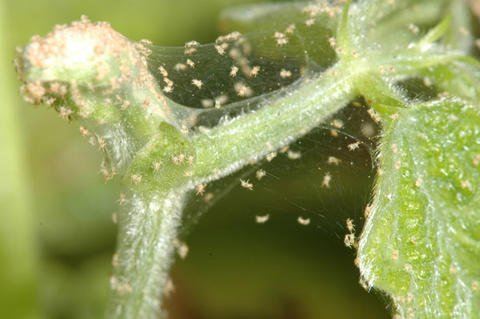SPIDER MITES
What are Spider Mites
Spider mites are one of the most common pests found on both indoor and outdoor plants. Spider mites are small arachnids in the family Tetranychidae that infest and feed on many types of plants1. Spider mites are extremely small light green bugs with two red eyespots and 8 legs. Females have two dark blotches on either side of their bodies. Eggs are small translucent to white dots that may look like a small water droplet. They live on the underside of leaves where they feed on plants by piercing the leaves with their mouthparts and drinking the plant sap. Spider mites can mate asexually and hatch in as little as 3 days after being laid. They can gain resistance to pesticides, making them difficult to treat2.
How to Detect Spider Mite Infestation
Spider mites can be difficult to detect when present only in small numbers due to their tiny size. Magnification tools can be helpful to both detect and identify mites. Low levels of infestation can appear as small white or yellow spots, or as lines on the leaves of the plant. A heavier infestation will be evident by the silk webbing these pests produce, covering parts of the plant in a thin spider web, which often has the mites crawling on them.

What Causes Spider Mites
Spider mites are most commonly transmitted to plants on people, in soil, or on infected plants that have been brought into contact with uninfected plants. Spider mites enjoy dryer air and hotter temperatures (90+oF). These conditions can cause their populations to rapidly increase.
How Spider Mites Impact Your Plants
Spider mite infestations cause a loss in plant yield and can even kill a crop completely.
Treatment & Prevention
Sprays & Foggers
Once your plant is infested you have a few options for treatment. High-pressure water can knock the mites off of your plants, but this is only a temporary fix as they may climb back on. Insecticide sprays like pyrethrin, insecticidal soap, and 86 can be used to treat mite infestation. A fine mist produced with a sprayer or fogger is ideal because of the high surface area they cover. Be sure to do any spray treatment before applying beneficial insects or you may kill them along with the pests. Always be cautious of what you spray on plants that you will consume, be sure to clean any produce before eating if chemicals have been sprayed.
If you are growing a plant that can not be washed like cannabis, it is highly recommended to not spray chemicals like the insecticides mentioned above, while in the flowering stage. If mites are detected during the flowering stage, isopropyl alcohol can be sprayed when diluted 1:4 with water to kill spider mites. Isopropyl alcohol is generally not as effective as insecticides but is a great option during flowering. With any spray, it is suggested to test it on a single leaf before using it on the whole plant, and spray only early in the morning or late at night. This is because bright light may cause damage to plants that have been sprayed by chemicals.
Environment
If you can do it safely, Increasing the CO2 level to 60% and the temperature to 86oF for 16 hours will kill all life stages of spider mites3.

Beneficial Insects
Certain beneficial insects such as predatory mites, some lady beetle species, and green lacewings prey upon spider mites and will help reduce their populations. These beneficial insects are a good option if there is a light infestation or if insecticide sprays can not be used. In addition, beneficial insects can work well to support the prevention of spider mite outbreaks. When releasing beneficial insects, it is important to follow the release instruction and ensure you have the right climate to support them. Warning, be sure to refrain from spraying any insecticides after you have released the beneficial insects as these can be harmful to their populations.
Prevention
The best thing any grower can do is prevent infestation in the first place by following these basic tips:
- Use a reputable soil source. outdoor compost, if not treated properly, can harbor a wide variety of pests.
- Be cautious not to enter your grow area after being exposed to other plants or nurseries. Ideally, you would change your clothes and bathe before coming into contact with your plants.
- Be sure to decontaminate new plants or cuttings by dunking them in insecticidal soap and quarantining them before bringing them into contact with your other plants.
- Regularly treat plants and soil with products like insecticidal soap, neem oil, mercenary, or even beneficial insects such as predatory mites to prevent pests from taking over your plants.
- Prevent plant stress, such as drought, to ensure your plants can fight off pests with their natural defenses.
- Keep the climate in your grow area unfavorable for pests; for example, lower temperature (~75-80 oF) and higher humidity (~50%-60%) can help prevent spider mites from surviving in your grow room.
Spider mites can be tricky to deal with, but there are a few methods to use. If it is too late for preventative methods, a combination of insecticides and beneficial insects should eradicate your spider mite problem.
Shop Spider Mite Prevention
Our spider mite treatment products
References:
- https://extension.umn.edu/yard-and-garden-insects/spider-mites
- http://ipm.ucanr.edu/PMG/PESTNOTES/pn7405.html
- https://doi.org/10.1303/jjaez.2013.249 (This paper is in Japanese but Google has an awesome pdf translation feature)
Resources:
Info on what beneficial insects work on what pest
Biocontrol & Pesticide compatibility lookup

